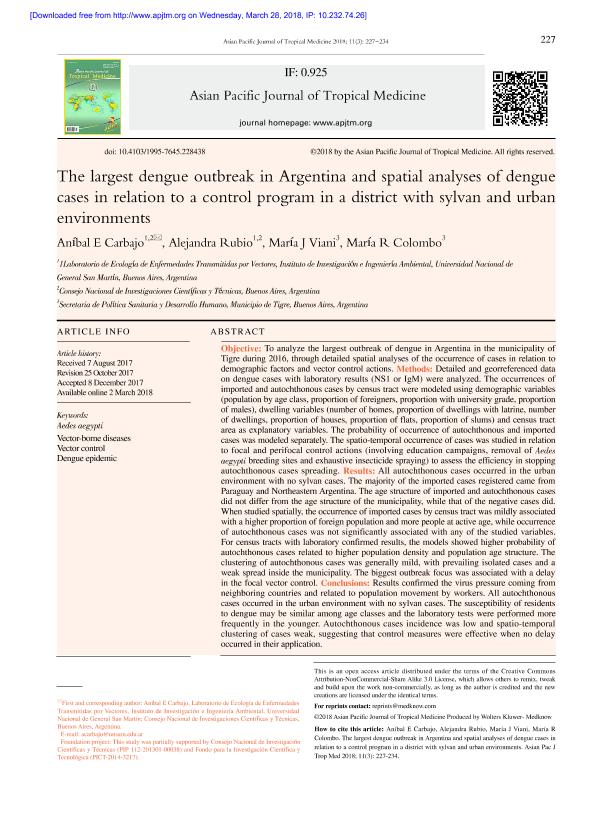Mostrar el registro sencillo del ítem
dc.contributor.author
Carbajo, Anibal Eduardo

dc.contributor.author
Rubio, Alejandra

dc.contributor.author
Viani, María
dc.contributor.author
Colombo, María
dc.date.available
2022-11-09T22:38:23Z
dc.date.issued
2018-04
dc.identifier.citation
Carbajo, Anibal Eduardo; Rubio, Alejandra; Viani, María; Colombo, María; The largest dengue outbreak in Argentina and spatial analyses of dengue cases in relation to a control program in a district with sylvan and urban environments; Hainan Medical College; Asian Pacific Journal of Tropical Medicine; 11; 3; 4-2018; 227-234
dc.identifier.issn
1995-7645
dc.identifier.uri
http://hdl.handle.net/11336/177162
dc.description.abstract
Objective: To analyze the largest outbreak of dengue in Argentina in the municipality of Tigre during 2016, through detailed spatial analyses of the occurrence of cases in relation to demographic factors and vector control actions. Methods: Detailed and georreferenced data on dengue cases with laboratory results (NS1 or IgM) were analyzed. The occurrences of imported and autochthonous cases by census tract were modeled using demographic variables (population by age class, proportion of foreigners, proportion with university grade, proportion of males), dwelling variables (number of homes, proportion of dwellings with latrine, number of dwellings, proportion of houses, proportion of flats, proportion of slums) and census tract area as explanatory variables. The probability of occurrence of autochthonous and imported cases was modeled separately. The spatio-temporal occurrence of cases was studied in relation to focal and perifocal control actions (involving education campaigns, removal of Aedes aegypti breeding sites and exhaustive insecticide spraying) to assess the efficiency in stopping autochthonous cases spreading. Results: All autochthonous cases occurred in the urban environment with no sylvan cases. The majority of the imported cases registered came from Paraguay and Northeastern Argentina. The age structure of imported and autochthonous cases did not differ from the age structure of the municipality, while that of the negative cases did. When studied spatially, the occurrence of imported cases by census tract was mildly associated with a higher proportion of foreign population and more people at active age, while occurrence of autochthonous cases was not significantly associated with any of the studied variables. For census tracts with laboratory confirmed results, the models showed higher probability of autochthonous cases related to higher population density and population age structure. The clustering of autochthonous cases was generally mild, with prevailing isolated cases and a weak spread inside the municipality. The biggest outbreak focus was associated with a delay in the focal vector control. Conclusions: Results confirmed the virus pressure coming from neighboring countries and related to population movement by workers. All autochthonous cases occurred in the urban environment with no sylvan cases. The susceptibility of residents to dengue may be similar among age classes and the laboratory tests were performed more frequently in the younger. Autochthonous cases incidence was low and spatio-temporal clustering of cases weak, suggesting that control measures were effective when no delay occurred in their application.
dc.format
application/pdf
dc.language.iso
eng
dc.publisher
Hainan Medical College
dc.rights
info:eu-repo/semantics/openAccess
dc.rights.uri
https://creativecommons.org/licenses/by-nc-sa/2.5/ar/
dc.subject
AEDES AEGYPTI
dc.subject
DENGUE EPIDEMIC
dc.subject
VECTOR CONTROL
dc.subject
VECTOR-BORNE DISEASES
dc.subject.classification
Epidemiología

dc.subject.classification
Ciencias de la Salud

dc.subject.classification
CIENCIAS MÉDICAS Y DE LA SALUD

dc.title
The largest dengue outbreak in Argentina and spatial analyses of dengue cases in relation to a control program in a district with sylvan and urban environments
dc.type
info:eu-repo/semantics/article
dc.type
info:ar-repo/semantics/artículo
dc.type
info:eu-repo/semantics/publishedVersion
dc.date.updated
2022-11-03T12:55:10Z
dc.journal.volume
11
dc.journal.number
3
dc.journal.pagination
227-234
dc.journal.pais
China

dc.description.fil
Fil: Carbajo, Anibal Eduardo. Universidad Nacional de San Martín. Instituto de Investigaciones e Ingeniería Ambiental. Laboratorio de Ecología de Enfermedades Transmitidas por Vectores; Argentina. Consejo Nacional de Investigaciones Científicas y Técnicas; Argentina
dc.description.fil
Fil: Rubio, Alejandra. Universidad Nacional de San Martín. Instituto de Investigación e Ingeniería Ambiental. - Consejo Nacional de Investigaciones Científicas y Técnicas. Oficina de Coordinación Administrativa Parque Centenario. Instituto de Investigación e Ingeniería Ambiental; Argentina
dc.description.fil
Fil: Viani, María. Universidad Nacional de San Martín. Instituto de Investigaciones e Ingeniería Ambiental. Laboratorio de Ecología de Enfermedades Transmitidas por Vectores; Argentina
dc.description.fil
Fil: Colombo, María. Universidad Nacional de San Martín. Instituto de Investigación e Ingeniería Ambiental. - Consejo Nacional de Investigaciones Científicas y Técnicas. Oficina de Coordinación Administrativa Parque Centenario. Instituto de Investigación e Ingeniería Ambiental; Argentina
dc.journal.title
Asian Pacific Journal of Tropical Medicine
dc.relation.alternativeid
info:eu-repo/semantics/altIdentifier/url/https://www.apjtm.org/article.asp?issn=1995-7645;year=2018;volume=11;issue=3;spage=227;epage=234;aulast=Carbajo
dc.relation.alternativeid
info:eu-repo/semantics/altIdentifier/doi/http://dx.doi.org/10.4103/1995-7645.228438
Archivos asociados
